Der nachfolgende Text basiert auf einem Auszug aus der GDI-Studie «Next Health», die Sie über unsere Website beziehen können.
Das langfristige Ziel des Gesundheitssystems scheint klar und von allen Stakeholdern anerkannt: ein gesundes und langes Leben für alle Menschen. Wie wir dieses Ziel erreichen können und wie das dafür benötigte System genau aussehen soll, darüber scheiden sich indes die Geister der involvierten Akteure. Aufgrund dieser unterschiedlichen Vorstellungen von den Wegen und von der Komplexität wird sich das Gesundheitssystem denn auch nicht als Ganzes komplett verändern. Geben wird es aber wichtige und grundlegende Veränderungen einzelner Aspekte – so genannte Shifts. Durch sie entstehen neue Möglichkeiten, neue Konstellationen und neue Beziehungen. Ein solcher Shift ist die immer intensivere Vermessung unseres Körpers.
Medikamentöse Behandlungen werden in Zukunft immer öfter unterstützt von und teilweise ersetzt durch digitale Verhaltens-Tools. Zum Beispiel könnte zusammen mit einem Schlafmittel auch eine App zur Messung des Schlafs verschrieben werden.

Mit der wachsenden Bedeutung der Prävention rückt der gesunde Lebensstil zunehmend in den Vordergrund. Wer ein Buch pro Woche liest, regelmässig joggt, länger als zwei Minuten täglich die Zähne putzt, zwei Tassen Kaffee pro Tag trinkt usw., der lebt länger. Die Ergebnisse zahlreicher Einzelstudien lassen sich dank der Verdatung des Lebens immer besser vernetzen, überprüfen und ein gesunder Lebensstil damit besser vermessen.
Das Gesundheitsbewusstsein wird sich tendenziell auf mehr Konsumbereiche ausbreiten und dadurch noch präsenter in unserem Leben werden. Die Wellness-Industrie, die weniger strengen Regulierungen unterliegt, geht dabei voraus und macht das Tracken von allerlei Gesundheitsdaten zunehmend normal. Wer seine Vitaldaten gewohnheitsmässig überwacht, wird bald auch erwarten, dass nicht nur die Nutzung von Turnschuhen, sondern auch die Wirkung von Medikamenten, wie zum Beispiel Blutdrucksenkern, automatisch überwacht und in Echtzeit ausgewertet wird. Das führt dazu, dass die Behandlung vieler physischer und mentaler Erkrankungen digitalisiert wird, was unter dem Begriff der «Digital Therapeutics» zusammengefasst wird. Ein Beispiel ist Sleepio – eine rezeptpflichtige Verhaltenstherapie für Schlafstörungen aus dem App Store.
Wenn wir anhand von Daten unseren Körper permanent überwachen können, entdecken wir womöglich Auffälligkeiten viel früher und können diese eher behandeln. Der Gang zur Ärztin ist womöglich immer seltener nötig. Sie, wiederum, kann sich dann viel öfter spezialisierten Behandlungen widmen.

Studie, 2020 (kostenloser Download)
Sprachen: Deutsch, Englisch, Französisch
Format: PDF
Im Auftrag von: sminds AG
Shift im System: Gesundheit 24/7
Das Gesundheitssystem ist im Wandel. Die stationäre Konsultation und Behandlung weicht immer mehr der Telemedizin. Die richtige Entwicklung?
Karin Frick über Telemedizin und die Wertschätzung der Spitäler
Die GDI-Forschungsleiterin nennt in der SRF-«Tagesschau» Veränderungen, die die Corona-Krise hervorgebracht hat.
Infografik: Wie KI das Gesundheitssystem neu sortiert 
Das Gesundheitssystem erfährt eine fundamentale Umwälzung. Präzisere Daten und künstliche Intelligenz ermächtigen Patienten und Pflegepersonal, Analysen und Behandlungen durchzuführen, die früher nur von Spezialisten bewältigt werden konnten. Verschwinden dadurch Arbeitsplätze?